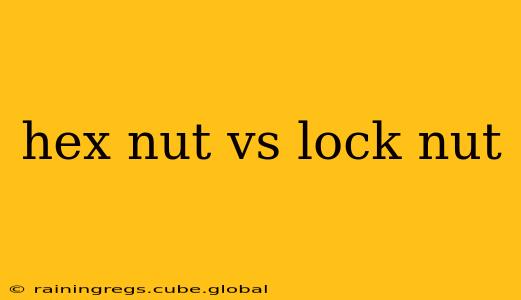Choosing the right fastener for your project is crucial for ensuring its safety and longevity. Two common types of nuts often cause confusion: hex nuts and lock nuts. While both are used to secure bolts, they differ significantly in their design and function. This guide will delve into the specifics of hex nuts versus lock nuts, clarifying their differences and helping you choose the appropriate fastener for your needs.
What is a Hex Nut?
A hex nut is a standard nut with six sides (hexagonal). Its simple design makes it incredibly versatile and widely used in countless applications. It's typically made from materials like steel, stainless steel, brass, or nylon, offering varying degrees of strength and corrosion resistance. Hex nuts are tightened and loosened using a wrench or socket that fits its hexagonal shape. Their straightforward design and mass production lead to a low cost, making them a popular choice for general fastening.
What is a Lock Nut?
A lock nut is designed to prevent loosening under vibration or stress. Unlike a standard hex nut, it incorporates a mechanism to resist vibrations and maintain its grip on the bolt. There are several types of lock nuts, each utilizing a different locking mechanism:
-
Nylon Insert Lock Nuts: These nuts contain a nylon insert that deforms slightly when tightened, creating friction against the bolt threads. This friction prevents the nut from loosening. They're a common and cost-effective choice for many applications.
-
All-Metal Lock Nuts: These nuts rely on various mechanical features to create a locking effect. Examples include:
- Castle Nuts: Feature slots for a cotter pin to secure the nut in place. They are often used in safety-critical applications where loosening could have serious consequences.
- Jam Nuts: Two standard nuts are tightened against each other, creating friction that prevents loosening. This is a simple and effective method, often used for critical applications where vibration is a concern.
- Prevailing Torque Nuts: These nuts have a deformed or serrated surface that helps to resist loosening.
What are the Key Differences Between Hex Nuts and Lock Nuts?
The primary difference lies in their function:
| Feature | Hex Nut | Lock Nut |
|---|---|---|
| Primary Function | Secure a bolt | Secure a bolt and prevent loosening |
| Locking Mechanism | None | Nylon insert, deformation, mechanical features |
| Vibration Resistance | Low | High |
| Cost | Low | Generally higher |
| Applications | General fastening | Applications requiring vibration resistance |
How do I choose between a hex nut and a lock nut?
The choice depends on the application's requirements:
-
Use a hex nut for: General fastening where vibration is minimal, such as assembling furniture or attaching non-critical components.
-
Use a lock nut for: Applications where vibration or stress is expected, such as automotive parts, machinery, or anything subject to significant movement or shaking. Consider the level of vibration and the potential consequences of loosening when selecting the specific type of lock nut.
What are the Different Types of Lock Nuts? (This answers a frequently asked question)
As mentioned above, there are many types of lock nuts, each with its own mechanism: nylon insert lock nuts, castle nuts, jam nuts, prevailing torque nuts, and others. The best type will depend on the specific application and the level of vibration resistance required. Factors like material, temperature, and required torque should also be considered.
Are lock nuts stronger than hex nuts?
The strength of a nut is primarily determined by the material it's made of, not whether it's a lock nut or a hex nut. A lock nut made of a weaker material will be less strong than a hex nut made of a stronger material. However, some lock nut designs may have slightly reduced strength compared to a standard hex nut due to their locking mechanisms.
What is the best type of lock nut for my application? (This answers another frequently asked question)
There's no single "best" lock nut. The ideal choice depends heavily on the specific application and the environmental conditions. Factors to consider include:
- Vibration level: Higher vibration requires a more robust locking mechanism.
- Temperature range: Some lock nut materials are better suited for extreme temperatures.
- Material compatibility: The nut must be compatible with the bolt material.
- Ease of installation and removal: Consider the ease of installation and the need for special tools.
Consult engineering specifications or fastener manufacturers for recommendations based on your specific needs.
By understanding the nuances between hex nuts and lock nuts, you can make informed decisions to ensure the reliability and safety of your projects. Remember to always prioritize safety and select the appropriate fastener for the intended application.
